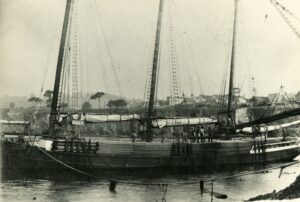
If there is only one vessel the Kelley House can feature during its current nautical exhibit, the Schooner J. C. Ford is a good choice.
In the May 20, 1882 issue of the “Mendocino Beacon” newspaper, it was reported the new three-masted schooner J. C. Ford had arrived. Messrs. Samuel B. Blair, Jerome C. Ford, and Edwards C. Williams, had it built in San Francisco, and it was under the command of Captain Griffith. With a length of 132 feet, 32 feet in breadth of beam, and 10 feet depth of hold, it was expected to carry 325,000 board feet of lumber for Mendocino capitalists, as well as general cargo and passengers.
The ship was claimed to be one of the finest specimens of naval architecture that had yet entered the port. Constructed with Puget Sound pine, the schooner was fastened as far as the float line with copper and locust tree nails. Galvanized iron nails were used from the float line to the deck, inside and out. The cabin’s fine accommodations for passengers featured ebony wood, beautifully grained black walnut paneling, and birds-eye maple.
In 1886, a story forwarded from the “Honolulu Press” reported that 17 days from San Francisco and loaded with general cargo, the Schooner J. C. Ford was hit by a fiery meteor, which set fire to the main masthead and burnt up the stay-sail. Large pieces of the burning scoria, or molten matter, fell upon the deck, burning up sails and the deck covering. The captain and crew quickly set to work to put out the fire and sails were cut away and thrown overboard. Water was hauled up in buckets to the masthead and the fire was extinguished. The injury to the mast was not sufficiently deep to require a new one, and the captain preserved cooled pieces of the lava-like meteor for display.
Such odd fiery encounters followed the ship to its tragic end. On February 2, 1893, the schooner foundered in squally weather at the entrance to Gray’s Harbor and lost the rudder. Keel to the main mast and starting to leak badly, the crew had no way to steer and could only manipulate the sails. For two days they pumped water out of the hold. But when the water reached barrels of quicklime stored in the cargo area, the white powder reacted with the seawater and released enough heat to ignite the ship. Fortunately, the eight-man crew was 25 miles off the coast, within the shipping lanes, and attracted the attention of the British sailing schooner Brenda, who saw the distress signals and rescued the crew as the beautiful J. C. Ford sank from sight.
Come by the Museum and check out the slideshow of other historic ships on display with the new exhibit “Wind & Water: The Nautical Collection of Norman de Vall,” opening August 30th through November 11th. Museum hours: 11 to 4, Fridays – Mondays. For more information call 707/937-5791 or go to kelleyhousemuseum.org.